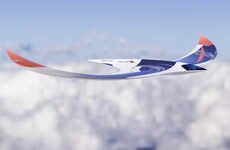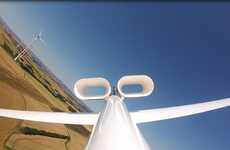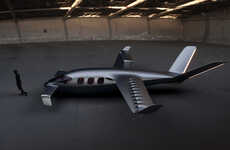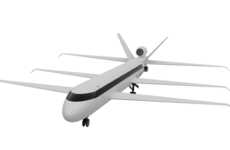
This High-Altitude Glider Uses Natural Airstreams to Achieve Elevation
Rahul Kalvapalle — September 5, 2018 — Autos
References: perlanproject.org & newatlas
European aerospace giant Airbus caused a giant stir when it first began unveiling plans for an engine-less high-altitude glider, but the end result is truly spectacular, with the Perlan 2 showcasing its ability to break an array of flight records.
Having demonstrated an ability to reach an altitude of 23 kilometers, the Perlan 2 high-altitude glider is designed to use high-power airstreams that occur in nature, instead of relying on gas-guzzling engines. For this reason, the glider is designed to be very lightweight, with its 500-kilogram weight and substantial 27-meter wingspan making for an ideal combination of low weight and high aerodynamic ability.
The aerospace world has always been a pioneer in testing and introducing new transportation technologies which have then gone on to inspire land transportation solutions, and the Perlan 2 high-altitude glider's ability to reach untold heights without an engine is something that could bode well for the commercial airliners of the future.
Having demonstrated an ability to reach an altitude of 23 kilometers, the Perlan 2 high-altitude glider is designed to use high-power airstreams that occur in nature, instead of relying on gas-guzzling engines. For this reason, the glider is designed to be very lightweight, with its 500-kilogram weight and substantial 27-meter wingspan making for an ideal combination of low weight and high aerodynamic ability.
The aerospace world has always been a pioneer in testing and introducing new transportation technologies which have then gone on to inspire land transportation solutions, and the Perlan 2 high-altitude glider's ability to reach untold heights without an engine is something that could bode well for the commercial airliners of the future.
Trend Themes
1. Engine-less Flight - Developing engine-less aircrafts using natural airflow has disruptive innovation potential in terms of efficiency and environmental impact on the aviation industry.
2. Lightweight Design - Creating lightweight aircrafts with scalable capabilities has disruptive innovation potential in reaching new heights and breaking flight records.
3. Aerodynamic Efficiency - Improving the aerodynamic efficiency of aviation technology using natural airstreams has disruptive innovation potential in achieving sustainability and reducing fuel consumption.
Industry Implications
1. Aerospace - Innovations in engine-less flight like the Perlan 2 high-altitude glider can revolutionize the aerospace industry's focus on sustainable energy solutions.
2. Aviation - Lightweight design using natural airflow can disrupt the aviation industry by improving flight efficiency and reducing environmental impact.
3. Transportation - The Perlan 2 high-altitude glider's breakthrough in altitude and weight demonstrates disruptive innovation potential in transportation beyond aviation, such as autonomous drones or air taxis.
1.1
Score
Popularity
Activity
Freshness























